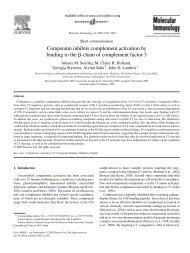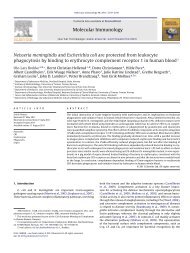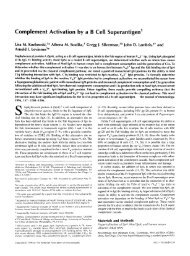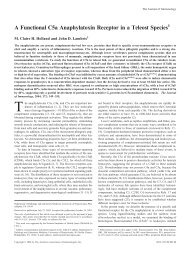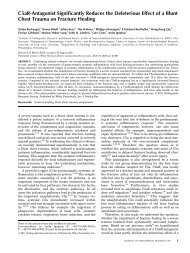IDENTIFICATION OF A C3bi-SPECIFIC ... - John D. Lambris
IDENTIFICATION OF A C3bi-SPECIFIC ... - John D. Lambris
IDENTIFICATION OF A C3bi-SPECIFIC ... - John D. Lambris
Create successful ePaper yourself
Turn your PDF publications into a flip-book with our unique Google optimized e-Paper software.
GORDON D. ROSS AND JOHN D. LAMBRIS 107<br />
in which lymphocytes are cultured with <strong>C3bi</strong>-ms with or without Fab'-anti-CR2<br />
might be able to answer this question.<br />
Summary<br />
Cells expressing a membrane C receptor (CRs) specific for C3b-inactivator-cleaved<br />
C3b (<strong>C3bi</strong>) were identified by rosette assay with <strong>C3bi</strong>-coated sheep erythrocytes<br />
(E<strong>C3bi</strong>) or <strong>C3bi</strong>-coated fluorescent microspheres (<strong>C3bi</strong>-ms). <strong>C3bi</strong>-ms, probably because<br />
of their smaller size, bound to a higher proportion of cells than did E<strong>C3bi</strong>.<br />
<strong>C3bi</strong>-ms bound to >90% of mature neutrophils, 85% of monocytes, 92% of erythrocytes,<br />
and 12% of peripheral blood lymphocytes. Binding of <strong>C3bi</strong>-ms to neutrophils,<br />
monocytes, and erythrocytes was inhibited by fluid-phase <strong>C3bi</strong>, Fab anti-C3c, or Fab<br />
anti-C3d but was not inhibited by F(ab')2 anti-CR~ (C3b receptor) or F(ab')2 anti-<br />
CR2 (C3d receptor) nor by fluid-phase C3b, C3c, or C3d. This indicated that<br />
monocytes, neutrophils, and erythrocytes expressed <strong>C3bi</strong> receptors (CRs) that were<br />
separate and distinct from CR1 and CR2 and specific for a site in the C3 molecule<br />
that was only exposed subsequently to cleavage of C3b by C3b inactivator and that<br />
was either destroyed, covered, or liberated by cleavage of <strong>C3bi</strong> into C3c and C3d<br />
fragments. Lymphocytes differed from these other cell types in that they expressed<br />
CR2 in addition to CRa. Lymphocyte <strong>C3bi</strong>-ms rosettes were inhibited from 50 to 84%<br />
by F(ab')2-anti-CR2 or fluid-phase C3d, whereas C3d-ms rosettes were inhibited<br />
completely by F(ab')2 anti-CR2, fluid-phase <strong>C3bi</strong>, or fluid-phase C3d. Thus, with<br />
lymphocytes, <strong>C3bi</strong> was bound to CRa, and in addition was bound to CR2 by way of<br />
the intact d region of the <strong>C3bi</strong> molecule. In studies of the acquisition of C receptors<br />
occurring during myeloid cell maturation, the ability to rosette with <strong>C3bi</strong>-coated<br />
particles was detected readily with immature low-density cells, whereas this ability<br />
was nearly undetectable with high density mature polymorphonuclear cells. This<br />
absence of <strong>C3bi</strong> binding to polymorphs was not due to a loss of the CR3 but instead<br />
was due to the maturation-linked acquisition of the abiity to secrete elastase that<br />
cleaved reagent particle-bound <strong>C3bi</strong> into CRs-unreactive C3d. Neither neutrophils<br />
nor monocytes bound C3d-coated particles at any stage of maturation. Assay of CR3<br />
with mature neutrophils required inhibition of neutrophil elastase with either soybean<br />
trypsin inhibitor or anti-elastase antibodies, and the amounts of these elastase inhibitors<br />
required to allow E<strong>C3bi</strong> rosette formation increased with neutrophil maturation.<br />
Because lymphocytes bound <strong>C3bi</strong> to CR2 as well as to CRa, specific assay of<br />
lymphocyte CR3 required saturation of membrane CR2 with Fab' anti-CR~ before<br />
assay for rosettes with <strong>C3bi</strong>-ms. Only 3.5% of anti-CR2-treated peripheral blood<br />
lymphocytes bound <strong>C3bi</strong>-ms. Therefore, among normal blood lymphocytes the majority<br />
of the 12% <strong>C3bi</strong>-ms-binding cells expressed only CR2 (8.5%), and the small<br />
proportion of <strong>C3bi</strong>-ms-binding cells that expressed CR3 (3.5%) represented a distinct<br />
subset from the CR2 + cells. Double-label assay indicated that 3.0% out of 3.5% of<br />
these CRs-bearing lymphocytes were B cells because they expressed membrane<br />
immunoglobulins. Of the remaining CR3 + cells, 0.2% expressed either Leu-1 or 3A1<br />
T cell antigens, and 0.6% expressed the OKM-1 monocyte-null lymphocyte determinant.<br />
Downloaded from www.jem.org on November 8, 2004<br />
The authors wish to acknowledge the excellent technical assistance of Ms. Joyce Knapp, Ms.





